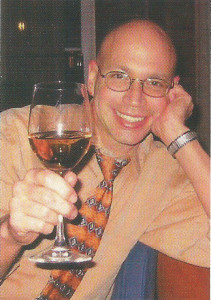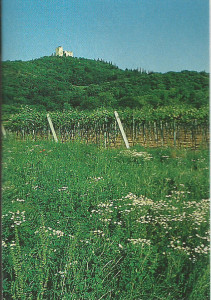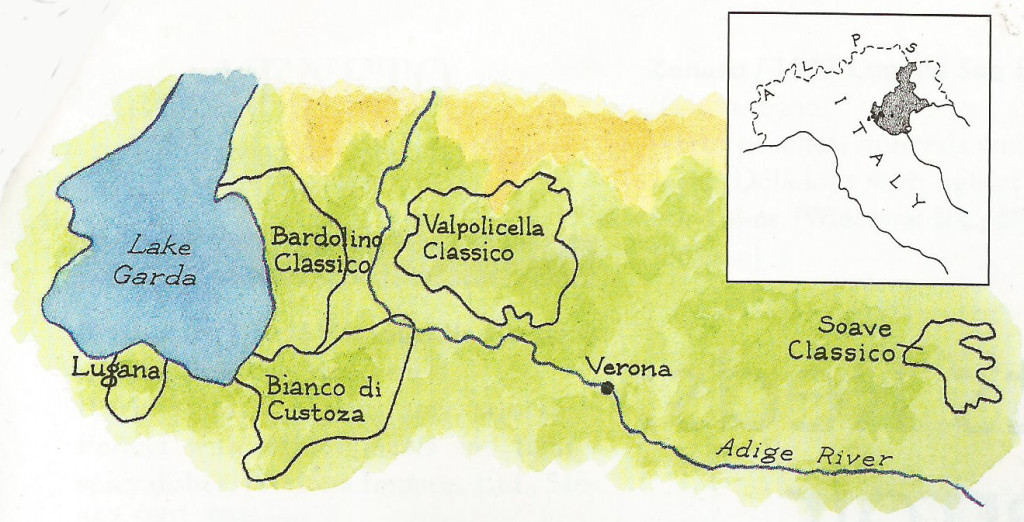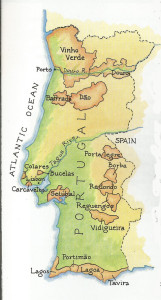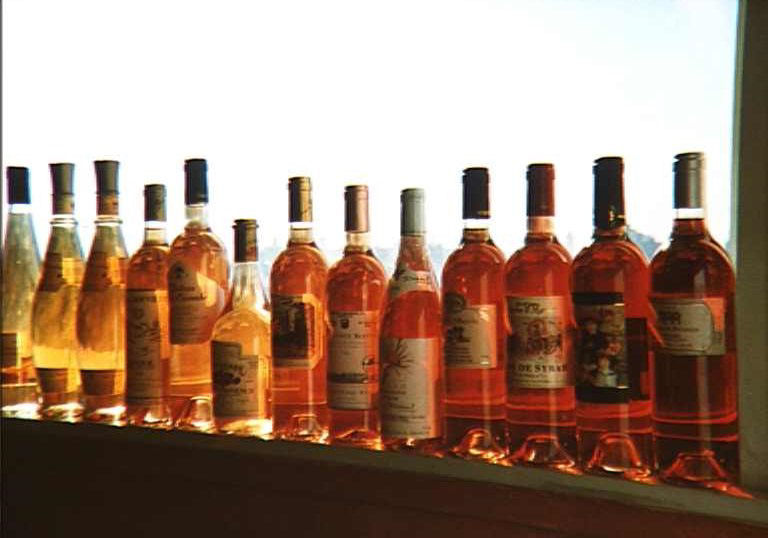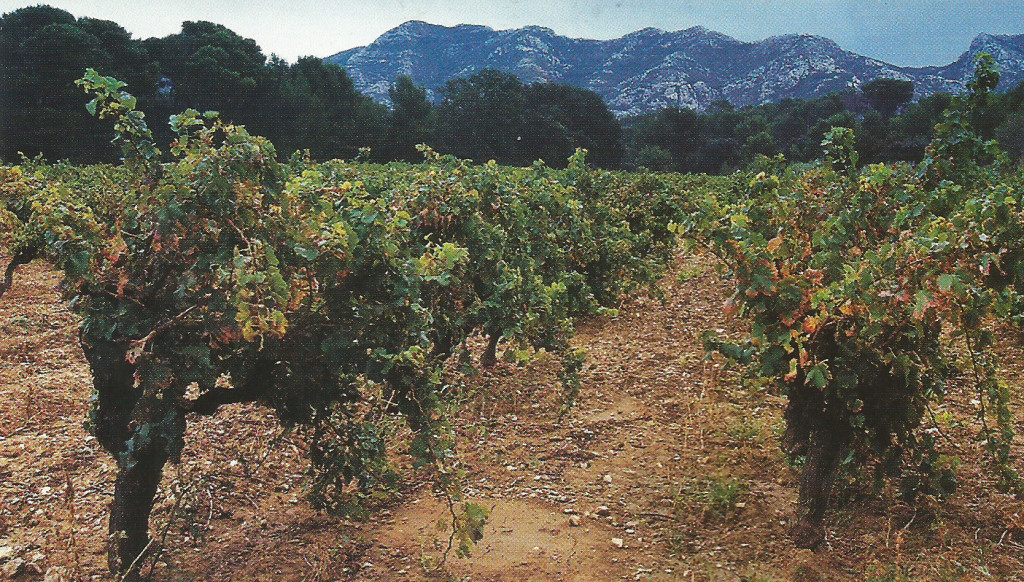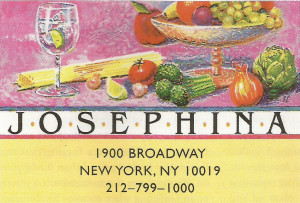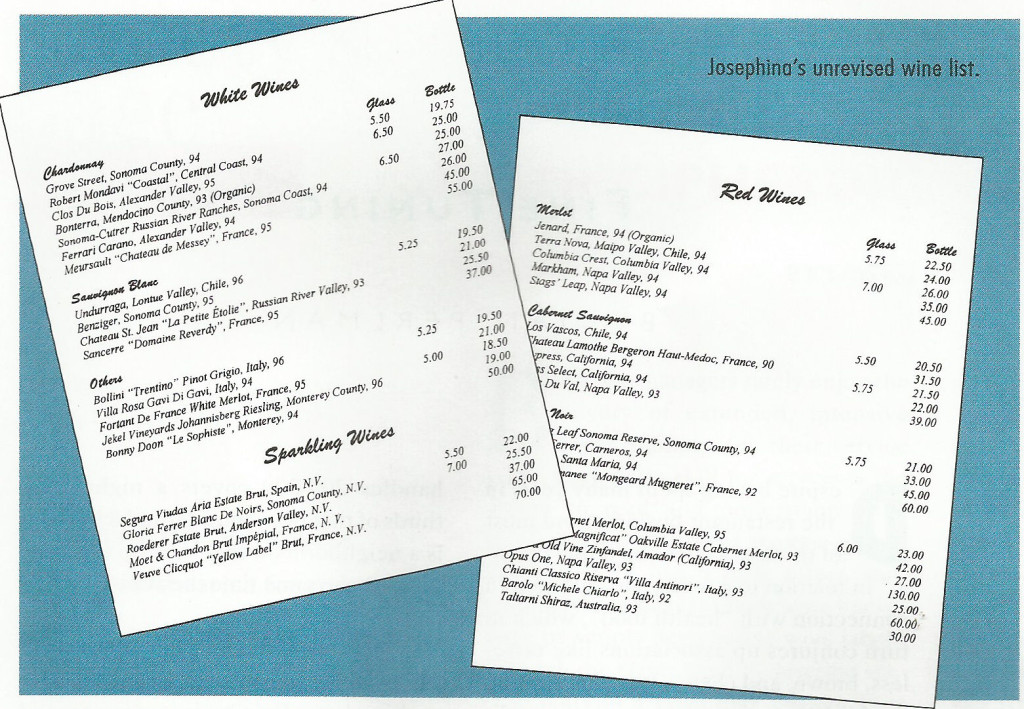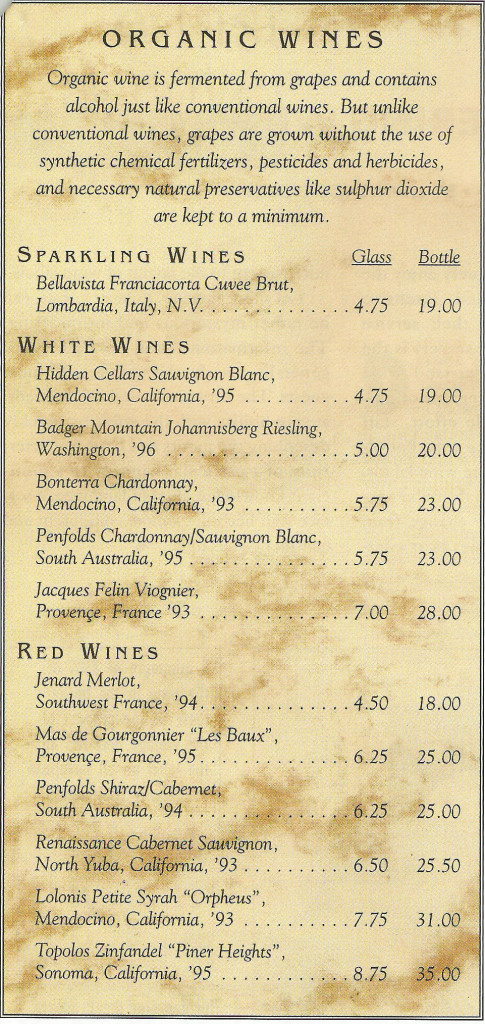Santé
The Magazine for Restaurant Professionals
April/May 1998
Page 32-33, 62-65
The Challenge of “Cheap, Light Whites”
You know the question. You dread hearing it. “Do you have a dry white wine? I only drink dry wines. And not too fruity.”
You already know that they’re on a budget. You can see it in their eyes. Nonetheless, someone at the table will make sure to make a joke about how poor they are and how inexpensive you should keep the bottle. Someone else at the table will tell you they like really light wines, like “Chardonnay or White Burgundy”. Where’s a sommelier to go from here?
Playing the Game
I’d like to say that it’s time for us to set the rules, but you know that isn’t going to happen. The customer sets the rules, we get to play the game. How we play the game is up to us. We have two options. We can opt for the easy route, the low road – pick them a nice, cheap, Chardonnay that will be the same as the last hundred bottles of wine they’ve had out in restaurants. Or, we can remember why we got into this business in the first place – the fun of educating and introducing our customers to wines they might otherwise not try. So what’s it going to be? Are you up for the game? Is your wine list?
There are thousands of inexpensive white wines out there in the world, and a huge portion of them are probably available in your market. Hopefully, you’ve found yourself some quality salespeople from your local distributors. You can give them the parameters, and they will show up with stuff actually worth drinking.
Unfortunately, too often, in too many parts of this country, salespeople are given quotas to fill. You don’t have the time to point them in the direction you’d really like to go, so you both end up settling for “a deal.” In simple terms, you end up with swill on your list that nobody really likes. The worst part is that your customers probably won’t tell you they didn’t like the cheap bar wine, or low-end bottle, but they will tell their friends.
Calling the Shots
My first challenge, in putting together a sampling of wines for “$30 and under light whites” was to figure out what they were. Pricing schemes around the country are so variable, even within any given market, that selecting a cut-off point is nearly impossible. A brief survey of quality restaurants here in New York City reveals markups that range from less than twice to over seven times cost.
I ended up opting for using my own restaurant’s pricing policy (twice plus $10), which gave me a cut-off somewhere in the $120-130 per case range. Although I didn’t set out to place a lower limit on cost, I found that in looking for quality wines that showed good varietal character (i.e., were not just innocuous, unidentifiable white wine), nothing under $60 per case made the cut.
“Light” is obviously just as subjective. My initial urge was to eliminate all Chardonnays, Viogniers and Semillons, because, in general, they are a bit fuller, but I decided that was unfair to the wineries that don’t go that route. Then I thought that I’d go for only wines that have no oak contact, but sometimes a little bit of oak just rounds out the wine.
I finally decided on a random selection and figured that I’d end up eliminating a few as I tasted. This turned out to be the case; two wines that I particularly enjoyed and highly recommend, Marqués de Murrieta’s “Ygay” Rioja Reserva, 1992 and Peter Lehmann’s Barossa Semillon, 1996, couldn’t be considered “light” by any definition of the word.
The Scoreboard
For my money, honors go to Sauvignon Blanc. Consistently, I found good varietal character, whether it was the classic Old World grassy style or the New World melon-scented and -flavored style. They were also, all around, a delight to drink, working well both on their own as aperitifs and pairing with a wide variety of cuisines.
In the minds of the public, and probably a large number of restaurant wine buyers, Italian white wines are automatically classified as light, simple, and undistinguished. Working with a predominately Italian winelist, I know that this is mostly myth. Not only are there numerous, fuller-bodied Italian whites, but more importantly, simple and undistinguished is anything but on target.
Surprisingly, only one pure Pinot Grigio made the cut. For the most part, those with enough quality to be of interest are priced out of the range I was reviewing. The majority of inexpensive Pinot Grigio could have just been labeled “white wine to wash food down with.” The most interesting whites from Italy were those that combined the talents of several grape varieties; some of them, such as the schizophrenic Franco-Italian blend in Montecarlo, have been made this way for years.
I was especially interested to see the white Rioja’s. I know that a lot of the producers have put an enormous investment in time and money into improving them over the last two decades. Gone, for the most part, is the heavy, oxidized style that characterized both white and red in this part of Spain. But reds have overshadowed the whites in the wine media, and it was delightful to discover the fresh, clean flavors these wines now have.
I’ve always liked really aromatic white wines, and Riesling and Gewürztraminer pretty much top the list. There aren’t many in the lower end range, especially for Gewürz, but it was a pleasure to find that there were some truly delicious choices available. Viognier, in a lighter style from southern France, also made the hit list.
Perhaps the nicest surprise was some of the odd-lot varietals that showed up on my doorstep. Colombard showed that it had the stuff to be something more than a blending grape. Chenin Blanc, a Loire Valley fave, really shines in some lower-end Californians. Chasan, a cross between Chardonnay and Palomino, was something I’d never tasted before, but hope to again.
The Post Game Show
None of us has a lot of free time. Between managing a wine cellar, managing our floor staff, writing and reading memos, and three thousand sundry chores that pop-up weekly, who has time to really taste through quantities of wine? Not to mention, and don’t let your restaurant owner see this, some of us want a social life.
Hopefully, I’ve done a little bit of the work for you, but the wines I’ve chosen are my own personal tastes, and may not even be available in your marketplace. You will need to put in a bit of time yourself: seeing what’s available locally, guiding your sales reps in what you want to add to your list, and, simply, tasting.
The tasting is key, of course. Because your customers will be doing just that when you pop a cork. Remember, whether your low-end light whites, or for that matter full whites, light reds or full reds, are good or bad, they’ll tell their friends, who will tell their friends, who will… Game’s over.
REVIEWER’S CHOICE
Carmenet / 1995 Edna Valley, Paragon Vineyard / Reserve / California
75% Sauvignon Blanc, 25% Semillon
Delicious orchard fruit, beeswax and honey make this one of the better white meritages that I’ve tasted. Borderline to be called light-bodied, but it could go either way.
Mazzini / 1996 Montecarlo Bianco / Tuscany, Italy
Pinot Bianco, Pinot Grigio, Semillon, Sauvignon Blanc, Roussanne, Vermentino, Trebbiano
Apples, pineapple and melons in a delicious round package. The complexity of the variety of grapes really shines through in this classic. Perfect with poultry.
Santa Rita / 1997 Sauvignon Blanc / Reserva / Chile
100% Sauvignon Blanc
Like its non-reserve counterpart, grapefruit and lemon, with grass and herbs, but more concentrated, more extracted, and, well, just more. Absolutely delicious with chicken or veal dishes.
The Full Line-up
Bertani Duè Uvè / 1995 / Italy
50% Pinot Grigio, 50% Sauvignon Blanc
Very green and grassy, grapefruit rind and a touch of spritz. Fresh and clean, this will work with stronger shellfish, especially with herbal sauces. [Palm Bay Imports, Inc, 516-362-9642, $92/case]
Bouchaine Dry Gewürztraminer / 1996 / Russian River Valley, California
100% Gewürztraminer
In classic style, this is chock full of lychees and rose petals in a bone-dry package. The acidity works beautifully with cheese dishes. [Bouchaine Vineyards, 707-252-9065, $100/case]
Carmenet / 1996 Colombard / Old Vines, Saviez Vineyard / Napa Valley, California
100% Colombard
Yeast, butter and fresh strawberries and raspberries made this a tasty surprise – it’s not often that Colombard shows this quality. A perfect brunch wine on a warm weekend afternoon. [Chalone Wine Group, 707-254-4250, $72/case]
Carmenet / 1995 Reserve, Paragon Vineyard / Edna Valley, California
75% Sauvignon Blanc, 25% Semillon
Delicious orchard fruit, beeswax and honey make this one of the better white meritages I’ve tasted. Borderline to be called light-bodied, but it could go either way. [Chalone Wine Group, 707-254-4250, $128/case]
Casa Julia / 1996 Sauvignon Blanc / Chile
100% Sauvignon Blanc
Fresh grapefruit, grapefruit rind and a touch of graham cracker sweetness. Perfect for sitting on the front stoop, steamy hot weather, watching the world go by. If you have an outdoor seating area, make this your summer bar pour. [T. Edward Wines, Ltd., 212-233-1504, $72/case]
Castello di Tassarolo / 1996 S Gavi / Italy
100% Cortese
Honeydew melon, lime juice and flowers with a slightly bitter finish – basically what Gavi should be. Try this with vegetable dishes, it will brighten the flavors all around. [Empson (U.S.A.) Inc., $124/case] (this review was left out of the final print article)
Coriole / 1996 Semillon-Sauvignon Blanc / McLaren Vale, South Australia
60% Semillon, 40% Sauvignon Blanc
Honey, beeswax, orange rind and spices, an absolutely delicious example of this blend. It worked beautifully with a chicken in orange sauce. [New World Wines Pty., Ltd., 202-244-3040, $120/case]
Duca di Salaparuta / 1995 Colomba Platino / Italy
80% Inzolia, 20% Grecanico
Honeydew melon, light spice and a touch of asparagus. A nice apertif wine, and a decent choice with lighter composed salads. [Paterno Imports, Ltd., 847-604-8900, $124/case]
Dry Creek Vineyards / 1996 Dry Chenin Blanc / Clarksburg, California
100% Chenin Blanc
Classic green apple and honey with a touch of yeastiness, this is what good Chenin Blanc is all about. Try the traditional match with oysters or clams on the half shell, or any good cold seafood platter. [Dry Creek Vineyard, 707-433-1000, $76/case]
Fillaboa / 1996 Albariño/ Rias Baixas, Spain
100% Albariño
Cantaloupe and limes, always a great combination. The bright acidity and smooth flavors worked really nicely with spicy, garlicky tapas. [European Cellars Direct, $128/case] (this review was left out of the final print article)
Georges Dubœuf / 1996 Saint-Véran / Burgundy, France
100% Chardonnay
Freshly picked apples and a touch of herbs – a great alternative when you don’t want a lot of oak and butter in your Chardonnay. [W.J. Deutsch & Sons Ltd., $89/case] (this review was left out of the final print article)
Gini / 1996 Soave Classico Superiore / Veneto, Italy
100% Garganega
Fresh lemons and citrus flowers with a bit of that Italian zip. Nice with lighter pastas, especially with a touch of cream or butter. [Michael Skurnik Wines, 516-677-9300, $108/case]
Grand Cru Vineyards / 1996 Chardonnay / California
100% Chardonnay
Buttery oak, pears and a touch of spice. Nicely put together and a truly decent choice with a lighter dinner. [Classic Wines of California, 800-692-5780, $80/case]
Hacienda / 1997 Clair de Lune Chardonnay / California
100% Chardonnay
Flat and watery, with little more to offer than too much new oak. Not recommended. [Hacienda Wine Cellars, $66/case] (this review was left out of the final print article)
Hidden Cellars / 1996 Sauvignon Blanc / Mendocino, California
100% Sauvignon Blanc
Saltwater taffy, cantaloupe and a touch of lemon zest show a radically different style than the typical Sauvignon Blanc, but it does say California white wine in spades. Nobody would be upset to be served a bottle of this. [Hidden Cellars Winery, 707-462-0301, $112/case]
Lolonis / 1996 Fumé Blanc / Redwood Valley, California
100% Sauvignon Blanc
Very forward melons and pears with a touch of yeast. Pairing this with a touch of chicken seems a perfect choice. [Lolonis Winery, 510-938-8066, $112/case]
Lungarotti / 1996 Bianco di Torgiano Torre di Giano / Umbria, Italy
70% Trebbiano, 30% Grechetto
Light and basic with lime zest and lime blossom notes and just a hint of spice. Good with lighter fare; try it with sushi! [Paterno Imports, Ltd., 847-604-8900, $96/case]
Marco Felluga / 1996 Pinot Grigio / Friuli, Italy
100% Pinot Grigio
Crisp apples and spice with just a faint hint of metallic minerals. Delicious as a house pour and pairs beautifully with fish and lighter pasta dishes. [Felluga USA, Inc., 707-257-7453, $112/case]
Marqués de Cáceres / 1996 Rioja / Spain
100% Viura
Citrus, herbal and a touch of honey all blend together in this bright, easy drinking wine that is perfect as an apertif. It may be cliché, but try it with good tapas. [Vineyard Brands, Inc., 205-980-8802, $62/case]
Mazzini / 1996 Montecarlo Bianco / Tuscany, Italy
Pinot Bianco, Pinot Grigio, Semillon, Sauvignon Blanc, Roussanne, Vermentino, Trebbiano
Apples, pineapple and melons in a delicious round package. The complexity of the variety of grapes really shines through in this classic. Perfect with poultry. [Michael Skurnik Wines, 516-677-9300, $88/case]
Bodegas Montecillo / 1996 Rioja Viña Cumbrero / Spain
100% Viura
Honey, herbs, and citrus with just a touch of spritz. Perfect as an apertif or with lighter shellfish dishes. [W.J. Deutsch & Sons Ltd., 914-273-1221, $62/case]
Perrin / 1995 Réserve Côtes-du-Rhône / France
Grenache Blanc, Roussanne, Marsanne, Bourboulenc
Floral with a touch of honey and citrus, this is a simple, easy drinking wine. Works well as an apertif or slightly premium bar pour. [Vineyard Brands, Inc., $96] (this review was left out of the final print article)
S.A.T. Los Curros / 1996 Rueda Tierra Buena / Spain
50% Verdejo, 50% Viura
Toast and herbs dominate a touch of orchard fruits with a long, spicy finish. A nicely balanced package that will stand up to boldly flavored foods. [The Barcelona Collection, Ltd., 904-280-1156, $56/case]
S.A.T. Los Curros / 1996 Rueda Viña Cantosán / Spain
100% Verdejo
Honeydew melon and straw with bright acidity, this is a very pleasant, easy drinking wine that I would be most happy with as an apertif. [The Barcelona Collection, Ltd., 904-280-1156, $61/case] (this review was left out of the final print article)
Sanford / 1996 Sauvignon Blanc / Central Coast, California
100% Sauvignon Blanc
Butter and honey dominate the nose, but the palate is balanced by bright melon and spice flavors. An interesting choice for those who like fruitier wines, pairs well with spicy foods. [Sanford Winery, 805-688-3300, $100/case]
Santa Rita / 1997 Sauvignon Blanc 120 / Maule Valley, Chile
100% Sauvignon Blanc
Zesty grapefruit and lemon juices with a touch of grass and herbs. Perfect with a chicken salad lunch or just to drink as an apertif. [Vineyard Brands, Inc., 205-980-8802, $65/case] (this review was left out of the final print article)
Santa Rita / 1997 Sauvignon Blanc Reserva / Maule Valley, Chile
100% Sauvignon Blanc
Like its non-reserve counterpart, grapefruit and lemon, with grass and herbs, but more concentrated, more extracted, and, well, just more. Absolutely delicious with chicken or veal dishes. [Vineyard Brands, Inc., 205-980-8802, $90/case]
Sella & Mosca / 1995 Vermentino di Sardegna / Sardinia, Italy
100% Vermentino
Consistent with the house style, this wine has nice herbal and citrus flavors and a bit of wheat germ on the nose. More of a spritz and slightly simpler than the “La Cala”, but quite similar. [Palm Bay Imports, Inc., 561-362-9642, $60/case] (this review was left out of the final print article)
Sella & Mosca / 1996 Vermentino di Sardegna La Cala / Sardinia, Italy
100% Vermentino
Light and crisp with a touch of a spritz. Citrus and herbal flavors with an interesting note of wheat germ. This works nicely with lighter pastas. [Palm Bay Imports, Inc., 561-362-9642, $80/case]
Stoneleigh / 1996 Sauvignon Blanc / New Zealand
100% Sauvignon Blanc
Intense grassiness and fresh raspberries are the hallmark of this classic. Delightful with shellfish and salads with strong vinaigrettes. [Dreyfus, Ashby & Co., 212-818-0770, $88/case]
Trefethen / 1996 Dry Riesling / Napa Valley, California
100% White Riesling
Light petrolly notes and a touch of orange rind, but somewhat neutral overall. An acceptable hot afternoon quaff. [Trefethen Vineyards, 707-255-7700, $108/case]
Vichon Mediterranean / 1995 Chasan / France
100% Chasan
Light and crisp with lots of bright citrus flavors and just a touch of herbs. This makes a really nice hot afternoon quaff and a delightful apertif. [Robert Mondavi Winery, 707-226-1395, $90/case]
Vichon Mediterranean / 1995 Viognier / France
100% Viognier
Classic aromas of peaches and cream in a fresh, light styled package. The perfect accompaniment to grilled chicken (and it stood up to a mustard sauce). {Robert Mondavi Winery, 707-226-1395, $90/case]
Weingut Kurt Darting / 1996 Riesling Kabinett Ungsteiner Bettelhaus / Germany
100% Johannisberg Riesling
Rose petals and sweet orange marmalade are as mouth-filling as the wine’s moniker. For someone who wants an off-dry wine, this is hard to beat. [Michael Skurnik Wines, Inc., 516-677-9300, $112/case]
Willamette Valley Vineyards / 1996 Pinot Gris / Oregon
97.5% Pinot Gris, 2.5% Chardonnay
Creamy smooth, with subtle flavors of tangerine and pepper, this wine stands up nicely to creamier cheeses, smoked or cured fish; in short, the perfect brunch wine. [Willamette Valley Vineyards, 800-344-9463, $120/case]
Willamette Valley Vineyards / 1996 Riesling / Oregon
90% Riesling, 9% Müller-Thurgau, 1% Muscat
Peaches and cream, floral notes and limes, the latter especially on the finish. Notedly sweet, though with good acidity to balance. Great with a cold shellfish platter. [Willamette Valley Vineyards, 800-344-9463, $80/case]
Yarra Ridge / 1996 Sauvignon Blanc / Yarra Valley, Victoria, Australia
100% Sauvignon Blanc
Butter, grass and concentrated cantaloupe – the style screams Australia. The balance is just right for a chilled shellfish platter. [Mildara Blass Wines, Inc., 919-846-5800, $98/case]
Santé is a glossy format trade magazine for restaurant wine buyers and educators. I wrote as a freelancer for them on and off from the first issue in November 1996 until November 2002 when they decided to stop using freelance writers.





